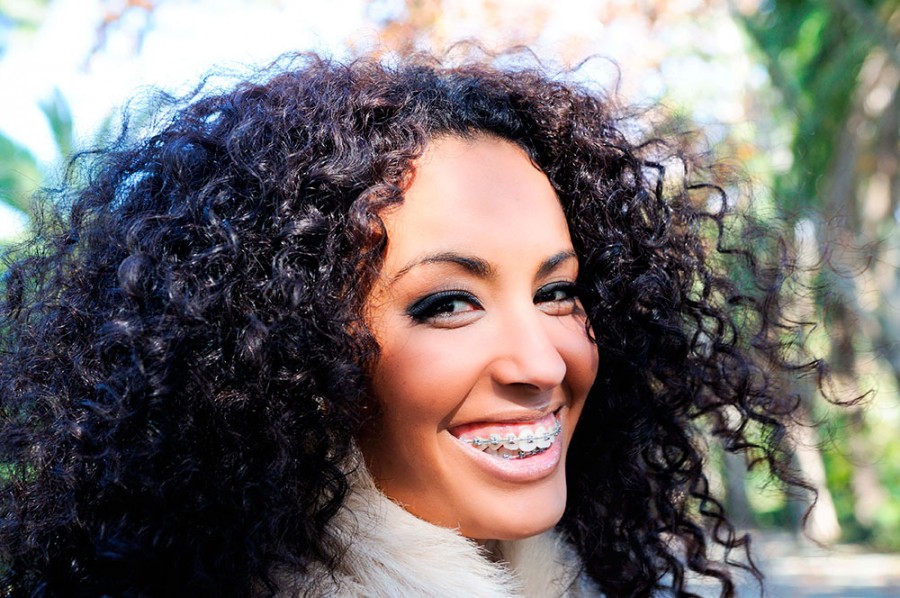As a child, Tina McDermott received dental advice that was commonly given in the ‘80s. “My teeth weren’t horribly crooked,” she says, “so my dentist told my mom that I didn’t need braces, and that I could keep my wisdom teeth.”
Once considered to be primarily cosmetic, orthodontic treatment is now seen as a way to preserve dental health.
A couple of years ago, McDermott’s dentist suggested that in addition to getting her wisdom teeth pulled, she should consider braces to avoid future dental problems. “I had wished my teeth were straighter and that I didn’t have an overbite,” she says, “but I didn’t seriously consider treatment until I learned that it would increase the likelihood that I would need dentures if I didn’t.”
According to a 2013 patient survey by the American Association of Orthodontists (AAO), the number of adults undergoing orthodontic treatment is on the rise. Nationally, adults now comprise about 20 percent of orthodontic patients. Orthodontist Dr. Charles Cooley of Redding says adults make up about 40 percent of his practice. Half these adults are self-referrals. “They’ve already gotten treatment for their kids, and have decided it’s their turn,” says Cooley. The other half are referred by dentists who see a breakdown of dentition resulting from a poor bite. “When I correct the bite,” says Cooley, “the longevity of dental restorations, such as crowns and caps, will be greater.”
Dental health and cosmetic appearance are not separate issues. Orthodontist Dr. Scott Hood of Chico says, “The understanding of what orthodontic treatment can do, both aesthetically and functionally, has increased among the general public as well as the dental community. Today there is much collaboration among dentists, orthodontists, periodontists, and oral surgeons to ensure a healthy and cosmetically appealing outcome for the patient.”
While conceding that patients are often motivated by appearance, Cooley adds, “There’s rarely a treatment I will do purely for cosmetic reasons. I want to treat the patient for function. The better your teeth function, the better position they’re in, and the better it’s going to look.”
Adults who seek orthodontic treatment may come with specific concerns, or even fears. Number one, Cooley says, is pain. “Adults still remember when their friends went in to have their wires tied, and all the headgear,” he says. “But the new technology and new metals have changed all that.” Innovations such as temperature-sensitive wires, gradual computer-generated adjustments, and temporary anchoring devices (TADs), have made severe mouth pain and bloody gums things of the past. And often such high-tech wizardry means less time in the chair, and more time between visits.
The AAO survey suggests that 70 percent of adults are concerned about the appearance of braces and other dental appliances. But such apprehensions tend to dissipate quickly once they’ve begun treatment. Orthodontia has become much less conspicuous over the last few decades, and a plethora of “invisible” options has brought more adults to the office. In addition to traditional metal braces, orthodontists offer:
- ceramic/clear brackets designed to blend better with tooth color,
- lingual braces positioned on the back (tongue side) of teeth, and
- clear aligners, which are custom made removable “trays.”
Orthodontic treatment can often remain a “secret” between patient and provider – until friends notice the new and improved smile!
There are financial concerns as well. The average cost of orthodontic treatment is $4500-$6500. Even with dental insurance, the patient’s out-of-pocket expense can be significant. Hood says, “A few patients pay up front, but most make monthly payments based on treatment time as well as treatment costs. Most orthodontists offer in-house financing, as well as ‘CareCredit’ type financing options.”
McDermott stresses the importance of interviewing several orthodontists before choosing one. Most provide a free consultation, during which the prospective patient receives a comprehensive exam, diagnosis, options for treatment, and answers to any questions. Hood says online sources can provide good preparation. “The higher the patient’s dental IQ, the better they understand the process and what to expect during treatment as well as the final outcome,” he says.
As for McDermott’s outcome? “I couldn’t be happier,” she says. “My treatment is coming to a close, and my teeth look so much better. They’re straight, and even more important, healthy. It’s no small thing to keep your teeth for life!”
Questions to Ask on Your First Visit to an Orthodontist:
- What potential problems have you identified?
- What is the likely outcome if I choose not to have treatment?
- What treatment options do I have?
- Please describe the treatment plan(s), step by step.
- How long will treatment take?
- What outcome can I reasonably expect?
- What is the total cost of treatment? How much will my insurance cover? Do you offer a payment plan for the remainder?
Modern Options for Braces
- Find photo examples at http://www.animated-teeth.com/dental-braces.
- Ceramic/clear: Contour, InVu, Reflections
- Self-ligating: Damon System, SmartClip, SPEED
- Lingual: Incognito, In-Ovation L, Harmony
- Invisible aligner: Invisalign, Clear Correct, Simpli5
Resources Mentioned: cooleyorthodontics.com, hoodortho.com, mylifemysmile.org
Posted in: Health & Nutrition
Comment Policy: All viewpoints are welcome, but comments should remain relevant. Personal attacks, profanity, and aggressive behavior are not allowed. No spam, advertising, or promoting of products/services. Please, only use your real name and limit the amount of links submitted in your comment.
Comments
Leave a Reply
You Might Also Like...

Putting Yourself On The Shelf? Parental Permission To Get A Life!
Don’t expect any alarms to go off when you turn your back on the things you once loved now that you have children. Most parents are unaware of any conscious […]

Less is More With Healthy, Pure Ingredients at Sarah Major’s Simple Living Company
To ensure good health: eat lightly, breathe deeply, live moderately, cultivate cheerfulness, and maintain an interest in life. — William Londen This timeless advice embodies Sarah Major’s “less is more” […]

Homemade Seaweed Snacks: Kid-approved … but may never make it into a lunch box!
Have you ever tried those salty seaweed snacks you buy at places like Trader Joe’s? I know, they’re addicting … we’ve tried them before and my children loved them! I […]

Camp Okizu: More Than Just Fun And Games
Camp Okizu expands across 500 acres at Berry Creek, 70 miles north of Sacramento, and embraces thousands of children and families every year. Four lakes, sleeping cabins and shower facilities […]





John Carston says
I’ve been researching orthodontists as I look into having adult braces done so this article has been very helpful. I didn’t know that letting crooked teeth or an underbite could lead to needing dentures, but I can see that is a risk I’ll have without teeth correction. I didn’t know that there are potions besides metal braces, but I’ll have to look into that more.
Johnny McCarron says
I really like that you talked about the questions to ask your orthodontist. My brother is getting braces soon, and we want to make sure he goes with the right orthodontist. Do you have any other tips about finding the right person to help you? We really just want to make sure that his oral health improves over the next couple of years.
Portland Braces says
You can get braces at either a child or adult. Regardless of your age, braces aren’t one-size-fits-all. Good read and Keep up the great work!